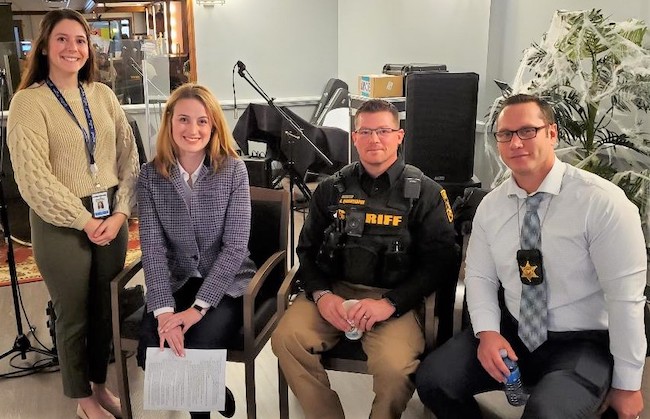Law enforcement, GCASA say fentanyl wreaking havoc locally
By Mike Pettinella, GCASA Publicist
BATAVIA – Those on the front lines in the battle against the opioid epidemic are unified in their message: Fentanyl is wreaking havoc across the United States, including right here in Genesee, Orleans and Wyoming counties.
“We’re seeing the human toll that fentanyl is having on our communities,” said Investigator Ryan DeLong of the Genesee County Sheriff’s Office, one of four speakers at this morning’s GOW Opioid Task Force meeting. “Probably everyone in this room has been affected (by substance use) by a family member or friend.”
DeLong and Deputy Ken Quackenbush, both trained as Drug Recognition Experts, spoke on what local law enforcement is dealing with as the scourge of fentanyl – a synthetic, prescription opioid that is 50 times stronger that heroin – has found its way, mostly from Rochester, into the rural counties.
They were joined by Emily Penrose, an epidemiologist with the Genesee County Health Department, who reported data on opioid-related deaths in Genesee and Orleans, and Christen Foley, task force coordinator, who described the basics of fentanyl and the telling signs of an overdose.
About 35 people attended the quarterly meeting at The Recovery Station, operated by Genesee/Orleans Council on Alcoholism and Substance Abuse, on Clinton Street Road.
DeLong and Quackenbush said that they are encountering scores of people using fentanyl through their road patrols and other drug crackdown initiatives. DeLong noted that the opioid is usually packaged in a wax envelope, about an inch square, but recently, they are finding it mixed with other substances for smoking purposes.
While police used to deal with heroin and other stimulants, Quackenbush said that he has “never seen heroin or seen heroin come back on a toxicology report” in his six years with the sheriff’s office.
“It’s always fentanyl,” he said.
Fentanyl is being distributed in both powder and pill form, with some pills in bright colors to mimic candy, the officers said. DeLong said fentanyl is much cheaper than heroin – a factor leading to its widespread use. Last year, more than 100,000 Americans died of opioid overdose.
DeLong explained that law enforcement is staying up to date in several ways on the drugs coming into the United States:
- Through regular emails from the federal government on packaging, quantities, forms and trends;
- Through communication among all local and regional police agencies;
- Through pro-active policing such as traffic stops and field testing of seizures (confirmed by lab results);
- Through narcotics trainings at both the “macro and local levels.”
“Every deputy carries and is trained in the administration of Naloxone (popular brand name, Narcan) and we respond to overdose calls for service along with EMS (Emergency Management Services) and fire (personnel),” DeLong said. “We’re also involved in the Public Safety Assisted Addiction and Recovery Initiative, where we link individuals to services through GCASA peer recovery advocates (without criminal implications) and conduct Drug Take-Back programs throughout the year.”
Penrose presented charts that showed a spike in opioid deaths in both Genesee and Orleans counties in 2017 and 2018 – both rates per 100,000 people well above the national average. She said the rate has decreased in the past three years but continues to be cause for concern.
“We’ve seen a big raise in fentanyl-related deaths since 2014, where before that, the overdose deaths mostly stemmed from heroin,” she said. “Additionally, we’ve seen fentanyl in stimulants such as cocaine, methamphetamine, ecstasy and bath salts.”
As far as leading causes of death in the U.S., unintentional injuries – including poisoning from alcohol and drugs – is the leading cause of death in every age group from 1 through 44.
“When you look deeper into unintentional injuries, we see that poisoning is the No. 1 cause for the 25-34, 35-44, 45-54 and 55-64 age groups – and that’s fentanyl,” she stated.
The health department is currently involved in a new initiative, HEALing Genesee, which is working to prevent overdose death through education and awareness, increasing access to Naloxone (which saves the lives of people experiencing an overdose) and safe prescribing practices.
The GOW Opioid Task Force, in conjunction with GCASA, regularly schedules trainings in Naloxone administration, Foley said.
“We encourage as many people as possible to get trained in how to administer Naloxone,” she said, noting that just 2 milligrams of fentanyl are considered a lethal dose in most people. “It’s important to know the signs of an overdose, which including drowsiness or unconsciousness, slow or shallow breathing, choking sounds or skin tone changes.”
For more information about Naloxone training or the task force, contact Foley at 585-815-1863.








































































